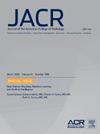重新评估无症状绝经后患者的子宫内膜厚度以排除癌症:系统回顾和荟萃分析。
IF 4
3区 医学
Q1 RADIOLOGY, NUCLEAR MEDICINE & MEDICAL IMAGING
引用次数: 0
摘要
目的:目前的 ACR 和 ACOG 指南建议,无症状绝经后患者排除子宫内膜癌的子宫内膜厚度阈值应≤4 mm。本系统综述和荟萃分析旨在重新评估有症状的绝经后患者通过造影排除子宫内膜癌的最佳子宫内膜厚度阈值:除灰色文献检索外,还对 MEDLINE、EMBASE、Cochrane Library 和 Scopus 从开始到 2023 年 10 月进行了系统检索。凡是对有症状的绝经后患者检测子宫内膜癌的子宫内膜厚度阈值的诊断准确性进行评估的研究均被纳入。参考标准为组织病理学。全文审阅和数据提取由两名审稿人独立完成。采用QUADAS-2工具评估偏倚风险和适用性。采用双变量混合效应回归模型进行了 Meta 分析:有 35 项研究、6302 名患者符合纳入标准。平均年龄为 51-68 岁。2-7毫米阈值的敏感性和特异性(95%置信区间)分别为:≤2毫米为95%(84-98%)和22%(8-49%),≤3毫米为94%(82-98%)和35%(24-47%)、95%(86-98%)和 45%(34-56%);≤5 毫米为 88%(75-95%)和 56%(42-68%);≤6 毫米为 84%(63-94%)和 60%(43-74%);≤7 毫米为 85%(56-96%)和 62%(49-73%)。各领域的研究被认为主要存在低偏倚风险:这项综合荟萃分析支持≤4 毫米的子宫内膜厚度阈值,可用于排除无症状绝经后患者的子宫内膜癌。本文章由计算机程序翻译,如有差异,请以英文原文为准。
Re-evaluating Endometrial Thickness in Symptomatic Postmenopausal Patients for Excluding Cancer: Systematic Review and Meta-Analysis
Purpose
The current ACR and American College of Obstetricians and Gynecologists guidelines recommend a ≤4-mm endometrial thickness threshold for excluding endometrial cancer in symptomatic postmenopausal patients. This systematic review and meta-analysis aims to re-evaluate the optimal endometrial thickness threshold on imaging for excluding cancer in symptomatic postmenopausal patients.
Materials and methods
A systematic search of MEDLINE, EMBASE, Cochrane Library, and Scopus from inception to October 2023 was performed in addition to a gray literature search. Studies were included if they evaluated the diagnostic imaging accuracy of endometrial thickness thresholds for detecting endometrial cancer in symptomatic postmenopausal patients. The reference standard was histopathology. Full-text review and data extraction were performed independently by two reviewers. Risk of bias and applicability were assessed using the Quality Assessment of Diagnostic Accuracy Studies-2 tool. Meta-analysis was performed using a bivariate mixed-effects regression model.
Results
Thirty-five studies with 6,302 patients met inclusion criteria. Mean age range was 51 to 68 years. The sensitivities and specificities with 95% confidence intervals for the 2- to 7-mm thresholds are 95% (84%-98%) and 22% (8%-49%) for ≤2 mm, 94% (82%-98%) and 35% (24%-47%) for ≤3 mm, 95% (86%-98%) and 45% (34%-56%) for ≤4 mm, 88% (75%-95%) and 56% (42%-68%) for ≤5 mm, 84% (63%-94%) and 60% (43%-74%) for ≤6 mm, and 85% (56%-96%) and 62% (49%-73%) for ≤7 mm. Studies were deemed predominantly low risk for bias across domains.
Conclusion
This comprehensive meta-analysis supports the ≤4-mm endometrial thickness threshold for excluding endometrial cancer in symptomatic postmenopausal patients.
求助全文
通过发布文献求助,成功后即可免费获取论文全文。
去求助
来源期刊

Journal of the American College of Radiology
RADIOLOGY, NUCLEAR MEDICINE & MEDICAL IMAGING-
CiteScore
6.30
自引率
8.90%
发文量
312
审稿时长
34 days
期刊介绍:
The official journal of the American College of Radiology, JACR informs its readers of timely, pertinent, and important topics affecting the practice of diagnostic radiologists, interventional radiologists, medical physicists, and radiation oncologists. In so doing, JACR improves their practices and helps optimize their role in the health care system. By providing a forum for informative, well-written articles on health policy, clinical practice, practice management, data science, and education, JACR engages readers in a dialogue that ultimately benefits patient care.
 求助内容:
求助内容: 应助结果提醒方式:
应助结果提醒方式:


